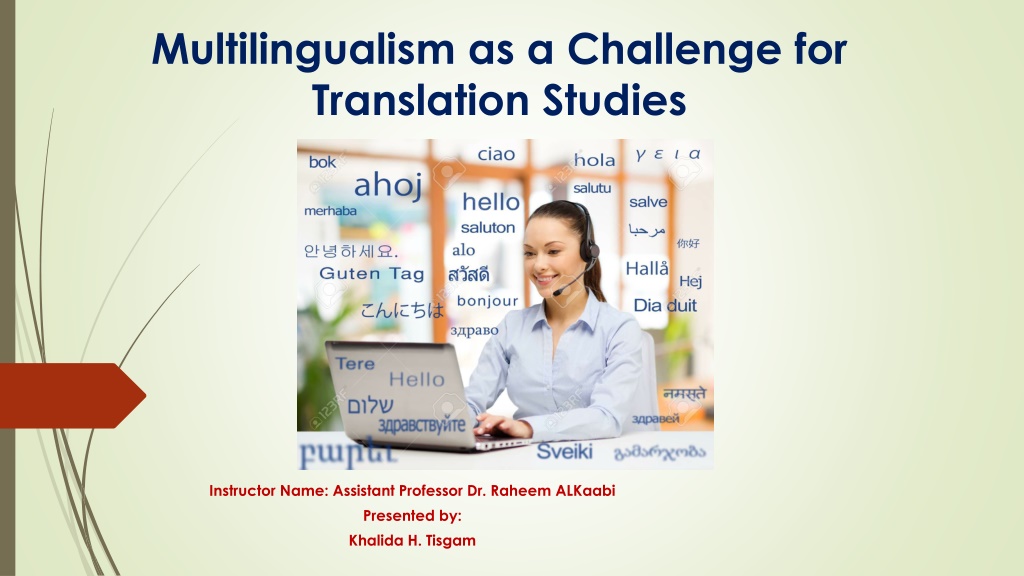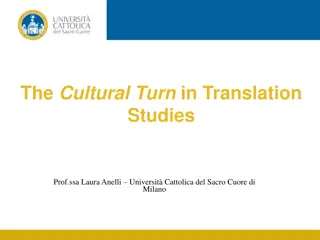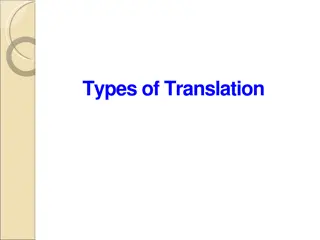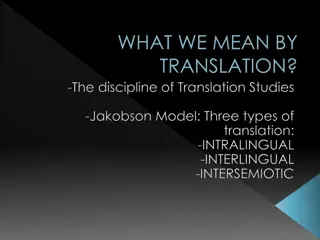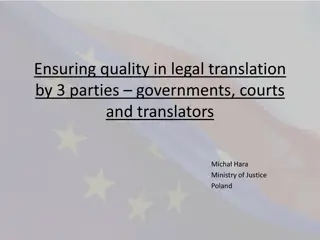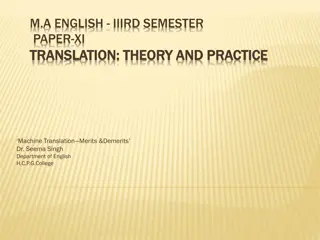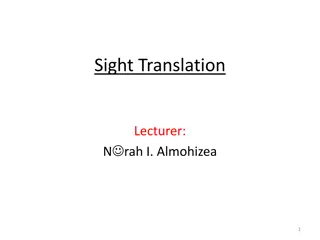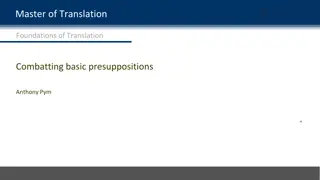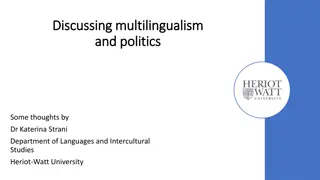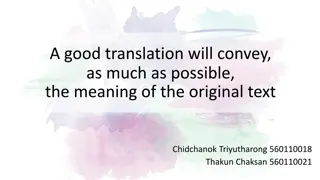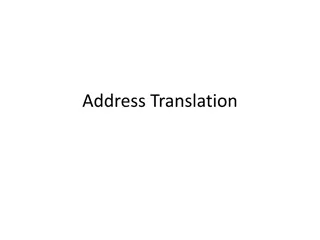The Impact of Multilingualism on Translation Studies
In a world embracing multilingualism, translators face new challenges when confronted with texts blending multiple languages. This phenomenon intertwines with translation, emphasizing the complex relationship between language, culture, and geography. Exploring literary multilingualism and its evolution from nationalistic ideals to postcolonial perspectives, this study delves into the intricate dynamics of translating in a multilingual society.
Download Presentation

Please find below an Image/Link to download the presentation.
The content on the website is provided AS IS for your information and personal use only. It may not be sold, licensed, or shared on other websites without obtaining consent from the author. Download presentation by click this link. If you encounter any issues during the download, it is possible that the publisher has removed the file from their server.
E N D
Presentation Transcript
Multilingualism as a Challenge for Translation Studies Instructor Name: Assistant Professor Dr. Raheem ALKaabi Presented by: Khalida H. Tisgam
Introduction In a growing multilingual world, translators have found themselves challenged by texts that mix two or more languages in their desire to express a bilingual reality inherent to a particular group of individuals. Multilingualism, commonly defined as the co-presence of two or more languages (in a society, text or individual) (Grutman 2009: 182) is inextricably linked with translation. At the heart of multilingualism, we find translation.
Due to the relativity of geography as a distinctive cultural feature, translations, both as a process and as a product may also belong to the source culture, which may determine the translation initiative, the selection of material to be translated, the translation strategies, the reception of the translations and the translation contacts or rules.
Translation and Multilingualism Texts People Institutions Societies
1. Multilingual texts Literary multilingualism may take on numerous forms: According to the quantity (one single word vs. entire passages) The type of foreignisms used (dialects, sociolects, foreign languages, etc.). It can fulfil various functions in terms of plot construction, character discourse and behaviour, mimesis, etc. Tolstoy s War and Peace(1868 9) Anthony Burges s A Clockwork Orange (1962) Umberto Eco s Il nome della Rosa (1980)
Since the birth of the nation state in the nineteenth century, literature and nation have been closely connected (Anderson, 1991: 45).Writing in a national language implied more than ever taking part in the construction of a national literature and culture. Writers considered their national literary language to be an expression of their national identity (being a French writer, an English poet, an Italian playwright, etc.) and they developed a (sometimes strong) loyalty to this national literary language (Grutman 2000). Language blending was easily associated with a flavour of treachery to the national literature, the people and the nation. From the postcolonial era onwards, literary multilingualism has gained new impetus. Postcolonial writers are commonly appreciated for using pidgins or creoles, which are a mixture, or blend, of imported European languages and local vernacular languages , as aesthetic, sociological and historical writing techniques
ST: ) " ) " T: All because of this woman, this daughter of a bitch, this contemptible carrier of dry sticks. The above religious expression The Quran describes the wife of Abo Lahab as the bearer of the firewood. Here, the translator translated dry sticks . Indeed, this text was translated for a group of readers who don t have the same cultural knowledge. Therefore, the translator should have elaborated the text by adding extra words to clarify the meaning or a footnote could have been included to give clues to the target text readers. We can say that this translation lacks cultural indications. is taken from the Holy Quran into carrier of A translator sometimes omits some parts of the original text in the process of translation. Omission is made for two reasons: Firstly, the untranslatability of some items due to the lack of equivalence in the TT. Secondly, the item might be odd or unacceptable to TT readers. To illustrate, let us consider the following examples:
Scholarly attention soon went beyond the postcolonial paradigm. It was Rainier Grutman who, in his study of the Quebec nineteenth-century novel (1997), coined the term heterolingualism (h t rolinguisme), referring to the use of foreign languages or social, regional and historical language varieties in literary texts. Designed to explain the effects of language mingling in literary texts, the concept offers a functional alternative for Bakhtin s more normative heteroglossia.
The writing and reading act of multilingual literary texts has been defined as an ongoing translation process between the languages involved. literary writing emanating from a bilingual or multilingual context where writing and translating overlap in a creative act literary multilingualism challenges the traditional definition of translation as the substitution of one language for another and of one literary text for another
2. Multilingual People According to the United Nations 2006 report on international migration, about 200 million people, or about 3 % of the world population, live outside the country where they were born. One effect of these massive migration flows is to change the linguistic landscape of these societies. Sociolinguistic studies have given a clear evidence of the fact that switching between languages in multilingual societies doesn t take place randomly, nor does it depend on individual initiatives, but is socially regulated and follows collective patterns of speech behaviour (Grutman 2009b: 13). Accordingly, a writer s multilingualism may be the result of his/her personal life story and/or of the specific societal context in which he/she grows up.
Translation Studies neglected multilingual writing and self-translation for two reasons: Translation Studies theorists insisted on the linguistic purity of its foundational figures, such as Chaucer and Dante, and they ignored the founders youthful translations of foreign texts. For centuries, theories of nation and genius erased the intercultural origins of literary innovation. The conceptual aspect: Since the bilingual text exists in two language systems simultaneously, how do the monolingual categories of author and original apply? Self-translation, the specific ways in which bilinguals rewrite a text in the second language and adapt it to a different sign system laden with its own literary and philosophical traditions, escapes the categories of text theory, for the text is twinned.
From the methodological point of view, analyses of texts resulting from multilingual instead of focusing on the dissimilarities between the various versions, should start from a point closer to the common core of the bilingual text, that is, within the textual intersections and overlaps of versions. writing or self-translation,
Why do multilingual writers leave the chance of reaching a larger reading public?
1. Lack of linguistic competence (perfect multilingualism is a rare phenomenon). 2. Literary writing is associated with creativity and uniqueness and is associated with a more than perfect command of languages, with stylistic creativeness. Unlike nonliterary translators who see themselves as mere craftsmen, multilingual writers and translators consider themselves inspired, independent spirits whose linguistic competence rarely reaches perfection. 3. Institutionalization: Languages and literatures are also and still heavily institutionalized practices. In so many past and present multilingual societies, the monolingualism of institutions (administration, legal affairs, education, army, political life, media, etc.) and a monolingual ideology contrast with the multilingualism of people on the ground.
Writing or self-translating in the dominant language certainly offers visibility and literary prestige but, especially in situations where the minority cultures are struggling for their linguistic emancipation, it is easily perceived by the minority groups as a treachery towards the minority language and literature, supporting the prestige and dominance of the majority language and literature. Instead, writing and/or self-translating in the minority language is perceived by the majority groups as an attack against their linguistic and literary supremacy (Meylaerts 2009b). Whenever hierarchies are outspoken, multilingual writers and self-translators risk having a hard life.
3. Multilingual Institutions The relations between translation and multilingualism are not confined to literature but are also constitutive for the whole domain of information services (e.g. printed and audiovisual media, press agencies, news rooms), of international institutions, of law and politics, of business, of technology, etc. in today s global world The relations between translation and multilingualism are not confined to literature but are also constitutive for the whole domain of information services (e.g. printed and audiovisual media, press agencies, news rooms), of international institutions, of law and politics, of business, of technology, etc. in today s global world. According to Pym (2008) NGOs are a good example of translation and multilingualism.
Pym Communication Strategies (i) The institution functions in one or two official languages obliging speakers of other languages to learn and operate in them (ii) NGOs can be multilingual and opt for the opposite strategy of multilateral translation. EU enacts that all languages translated into all other languages. (iii) The institution functions in one or two languages used on the inside (within the professional interculture), whereas translation is limited to communication between the inside and the outside, between the professional interculture and the client monocultures.
4. Multilingual Societies The notion of territoriality (a set of legal rules constraining the choice of the languages for purposes of education and communication) All over the world authorities are confronted with multilingual populations, whether historical minorities or new immigrants. Since democratic societies are based on the ideal of participating citizenship and since participating citizenship presupposes, among other things, the citizens right to communicate with the authorities, a fair linguistic and translational14 territoriality regime is a vital need for the survival of any democratic society. It is also an essential factor in minorities identity and integration because it determines their right to vote, to go to school, to receive official documents from the administration, etc.
National Authorities Options for Communicating with their Citizens 1. Complete Institutional Monolingualism (a national language for communication between authorities and citizens in education and public settings). 2. Complete Institutional Multilingualism (obligatory multidirectional translation in all languages for all). 3. Institutional Monolingualism (intermediate strategy combined with occasional and temporary translation into the minority languages). 4. Institutional Monolingualism at the local level and Institutional Multilingualism with multidirectional obligatory translation at the superior (federal) level (a combination of the three other ones).
Conclusion Translation is found at the heart of multilingualism, which constitutes a true challenge for translation studies. Many issues need to be understood within multilingualism, especially new forms of multilingual literature , the familiar distinctions between source and target or between import and export and finally the concept of translation itself. Besides, a true concern is needed for the concepts of literary writer and literary translator. Originality and creativity are no longer to be located at the author s side but are interwoven with multilingual writing and self-translating and thus also with translating. Translation studies can therefore contribute to a new and flexible conceptualization of roles within the overlapping practices between author, multilingual writer, self-translator, translator
Bibliography Blackledge, A. (2005) Discourse and Power in a Multilingual World, Amsterdam: John Benjamins. Bourdieu, Pierre (1972) Esquisse d une th orie de la pratique, Geneva: Droz. Goldfajn, Tal (2006) Non-homeland: When Translation Is Not a Footnote , RiLUnE 4: 151 66. Hokenson, Jan W. and Munson, Marcella (2007) The Bilingual Text: History and Theory of Literary Self-Translation, Manchester: St Jerome. Joppke, Christian (2007) Beyond National Models: Civic Integration Policies for Immigrants in Western Europe , West European Politics 30(1): 1 22 Pym, Anthony (1998) Method in Translation History, Manchester: St Jerome.
